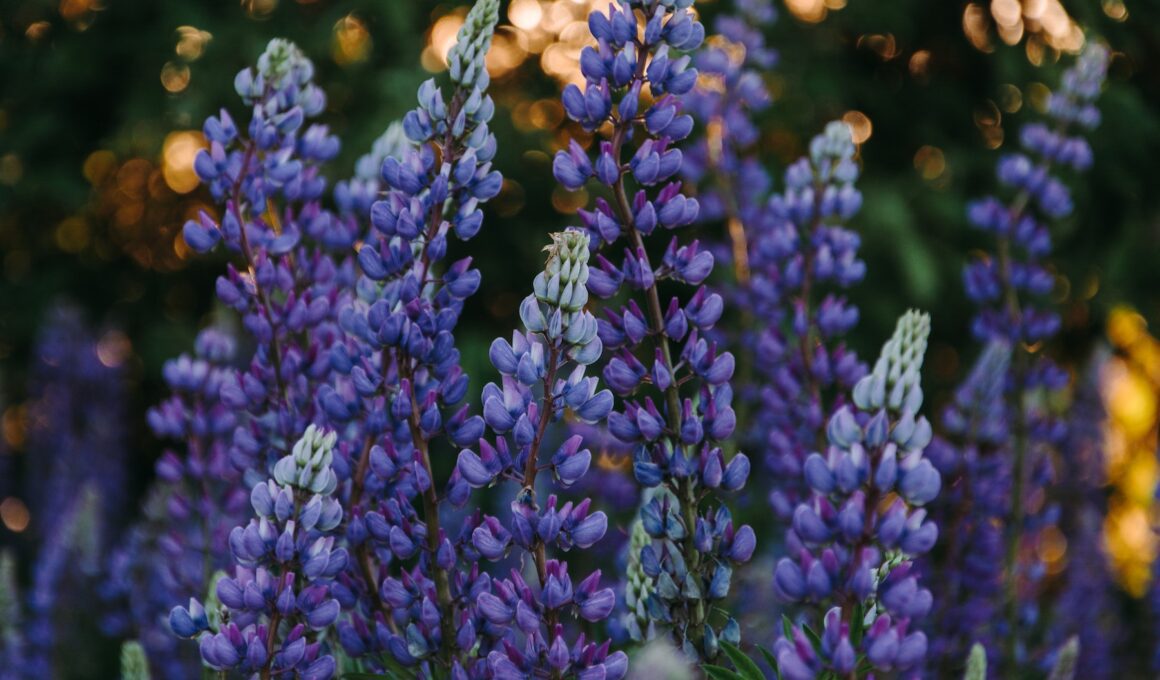Are you a fan of lupins and wondering if they’ll come back every year?
Well, the good news is that lupins are perennials, meaning they will come back year after year. However, there are factors that can affect their growth and survival, so it’s important to take care of them properly.
Lupins are beautiful and vibrant flowers that can add a pop of color to any garden. They also have a variety of benefits, such as attracting pollinators and providing nitrogen to the soil.
As someone who values safety and security, ensuring your lupins return every year is important to maintain the beauty and benefits of your garden. So, let’s dive into the world of lupin perennials and learn how to care for them to ensure their longevity.
Understanding Lupin Perennials
You’re probably wondering if these beautiful plants will return to your garden and continue to bloom for years to come. Well, the good news is that lupins are perennials, which means they’ll come back every year as long as you take care of them properly.
Lupin plant care is relatively simple, and planting lupins is easy too. To ensure that your lupins come back every year, make sure to plant them in well-draining soil with plenty of sunlight. Lupins prefer slightly acidic soil, so you may need to adjust the pH level if necessary.
Water your lupins regularly, but be careful not to overwater them as this can lead to root rot. In the fall, cut back your lupins to just a few inches above the ground. This will help them survive the winter and come back stronger next year.
As long as you take care of your lupins properly, they’ll return to your garden every year and provide you with beautiful blooms that’ll brighten up your yard.
Factors Affecting Lupin Growth and Survival
When it comes to lupin growth and survival, there are a few key factors to keep in mind.
Firstly, climate and soil conditions play a huge role in the success of your lupins.
Secondly, pests and diseases can quickly wreak havoc on your plants if left unchecked.
Lastly, proper watering and fertilization are essential for healthy, thriving lupins.
By paying attention to these three factors, you can ensure that your lupins will grow strong and beautiful year after year.
Climate and Soil Conditions
The climate and soil conditions needed for these plants to thrive are specific and must be carefully considered. Lupins are perennials, which means they can live for more than two years. But they can only survive if they have the right environment.
Here are some things you need to know about the climate and soil conditions for lupins:
-
Lupins need a climate that isn’t too hot or too cold. They grow best in areas with mild temperatures and moderate rainfall.
-
The soil needs to be well-drained and nutrient-rich. Lupins don’t tolerate wet soil, so make sure the water can drain away easily.
-
The pH level of the soil should be slightly acidic, around 6.0-6.5. If the soil is too alkaline, the plant may not be able to absorb the nutrients it needs.
By taking these factors into account, you can create the perfect environment for lupins to grow and thrive. With proper care and attention, they’ll come back every year.
Pests and Diseases
Maintaining optimal environmental conditions is not the only challenge to growing lupins successfully; pest and disease management is equally crucial. Common lupin pests include aphids, slugs, snails, and weevils. You can prevent infestations by practicing good garden hygiene, such as removing any dead plant matter and keeping the soil well-drained and aerated. Additionally, you can use organic pest control methods like introducing beneficial insects or using natural repellents like garlic or chili pepper spray.
Preventing lupin diseases is also essential to the plant’s health and longevity. Some common diseases that affect lupins include root rot, powdery mildew, and anthracnose. To prevent these diseases, make sure to plant lupins in well-drained soil and avoid overwatering. You can also use fungicides as a preventative measure. By being proactive in pest and disease management, you can ensure your lupins come back every year healthy and strong.
| Common Lupin Pests | Prevention Methods |
|---|---|
| Aphids | Introduce beneficial insects or use garlic/chili pepper spray |
| Slugs/Snails | Practice good garden hygiene, use slug/snail bait |
| Weevils | Introduce beneficial insects or use neem oil |
| Powdery Mildew | Plant in well-drained soil, avoid overwatering, use fungicides |
| Anthracnose | Plant in well-drained soil, avoid overwatering, use fungicides |
Watering and Fertilization
Properly watering and fertilizing your lupins is like nourishing a growing child, providing them with the necessary nutrients to thrive and blossom.
To ensure the health and longevity of your lupins, it’s crucial to provide them with proper hydration. This means watering them deeply and regularly, especially during hot and dry weather. Be sure to give them enough water to reach their roots, but avoid overwatering, which can lead to root rot and other issues.
In addition to proper hydration, lupins also require nutrient-rich soil to grow and produce beautiful blooms. Fertilize your lupins with a balanced fertilizer during their growing season, which typically occurs in the spring and summer months. This will provide them with the necessary nutrients, such as nitrogen, phosphorus, and potassium, for healthy growth and vibrant flowers.
Remember, properly watering and fertilizing your lupins will not only ensure their survival but also enhance their beauty and bloom potential.
Caring for Lupins
Take care of your lupins to ensure their growth and blooming each season. Lupins are perennials, which means they come back every year. However, they still need proper care to thrive.
One important aspect of caring for lupins is pruning. Deadheading (removing spent flowers) can encourage more blooms and prevent the plant from producing seeds, which can weaken the plant. Prune back any damaged or diseased stems to keep the plant healthy.
Companion planting can also benefit your lupins. Planting lupins near other plants can help deter pests and attract beneficial insects. For example, planting them with garlic or chives can repel aphids, which can damage the plant. On the other hand, planting them with marigolds can attract ladybugs, which eat aphids and other pests. Keep in mind that lupins prefer slightly acidic soil, so avoid planting them near plants that prefer alkaline soil.
In addition to pruning and companion planting, lupins need regular watering and fertilization. Water them deeply once a week, especially during dry spells. Fertilize them in the spring with a balanced fertilizer, and again in midsummer with a low-nitrogen fertilizer to encourage more blooms.
By taking these steps, you can ensure that your lupins come back strong and healthy each year.
Tips for Ensuring Lupins Return Every Year
You can ensure your garden is bursting with colorful blooms year after year by following these simple tips for keeping your lupins healthy and thriving.
Proper pruning techniques are essential for maintaining the health of your lupins. Deadheading spent blooms will encourage new growth and prevent the plant from diverting energy into producing seeds. Cut back the entire plant to ground level in the fall to promote healthy regrowth in the spring.
Propagation methods are also important for ensuring your lupins return year after year. Propagate your lupins by dividing the root system every few years in the fall. This won’t only keep the plant from becoming overcrowded but will also promote healthy growth and blooming. Additionally, collecting and planting seeds from your existing lupins can also be a successful method of propagation.
By following these simple tips, you can ensure your lupins return every year with beautiful and vibrant blooms. Be sure to prune your plants regularly and propagate them every few years to keep them healthy and strong. With these techniques, your lupins will be the shining star of your garden for years to come.
Do Lupins and Crocosmia Require Yearly Maintenance for Regrowth?
Yes, both lupins and crocosmia require yearly maintenance for regrowth. When it comes to crocosmia, cutting crocosmia back in autumn is essential for the health and regrowth of the plant. This encourages new growth and helps the plant to bloom beautifully in the following year.
Conclusion: Enjoying the Benefits of Lupin Perennials
Get ready to sit back and enjoy the beauty and benefits of these stunning lupin perennials in your garden! Lupins are not only gorgeous, but they also offer many benefits to your garden. They attract pollinators such as bees and butterflies, which help to fertilize other plants in your garden. Additionally, lupins can help to improve the soil quality by fixing nitrogen in the soil.
Lupin varieties come in a range of sizes, colors, and shapes, making them a versatile addition to any garden. From tall spires of blue, pink, or purple to shorter, compact plants, lupins can fit into any garden design. They also bloom in late spring to early summer, adding a burst of color to your garden when many other plants are not yet in bloom.
So, sit back and enjoy the many benefits of these stunning lupin perennials in your garden. They not only provide a beautiful display, but they also attract pollinators and improve soil quality. With so many varieties to choose from, you can find the perfect lupin to fit in with your garden design. Give them the care they need, and they’ll come back year after year, providing you with endless enjoyment.
Frequently Asked Questions
What is the best time of year to plant lupins?
To get the most out of your lupins, the best time to plant them is in early spring. This will give them the longest growing season and allow them to establish strong roots before the heat of summer.
When planting, consider using companion plants like marigolds or chives, which can repel pests and attract beneficial insects.
To protect your lupins from frost, cover them with a lightweight cloth or add a layer of mulch around the base of the plant.
These simple tips can help ensure that your lupins thrive year after year.
How often should I water my lupins?
To keep your lupins healthy and thriving, it’s important to water them regularly. How often you water your lupins depends on the amount of sunlight they receive and the type of soil they’re planted in.
As a general rule, lupins need to be watered about once a week, but if the weather is particularly hot or dry, you may need to water them more often. Make sure to water them deeply, so the water reaches the roots, and avoid getting the leaves wet, as this can lead to fungal diseases.
With the right watering frequency and sunlight exposure, your lupins will continue to bloom for years to come.
Can lupins be grown in containers?
Container gardening is a great way to grow lupins if you have limited space or want to move them around. Make sure you choose a pot that’s at least 12 inches deep and has drainage holes.
Use a well-draining potting mix and water regularly, but don’t let the soil become waterlogged. Pruning techniques can help keep your lupins healthy and promote more blooms.
In the spring, remove any dead or damaged leaves and cut back the stems to encourage new growth. With proper care, your lupins can thrive in a container and bring beauty to your space.
How do I prevent pests and diseases from affecting my lupins?
To ensure your lupins are healthy and pest-free, try companion planting with plants that naturally repel pests, such as marigolds or garlic.
Additionally, there are natural remedies you can use to ward off pests and diseases, such as neem oil or a mixture of water and dish soap.
Regularly inspect your lupins for any signs of pests or diseases, and promptly remove any affected leaves or plants.
By taking these preventative measures, you can enjoy healthy and vibrant lupins year after year.
Do lupins require any special soil conditions to thrive?
To ensure healthy growth and vibrant blooms, lupins require well-draining soil with a pH range of 6.0-7.5. Planting lupins at home is easy, but you must choose a suitable location with plenty of sunlight and good air circulation.
Avoid planting in areas with heavy clay or waterlogged soil as this can cause root rot. Before planting, prepare the soil by adding organic matter such as compost or well-rotted manure. This will improve soil structure, increase nutrient availability, and help retain moisture.
With the right soil conditions, your lupins will thrive and provide you with beautiful blooms year after year.
Conclusion
So, you want to know if lupins will come back every year? The answer is yes, lupins are perennials, which means they’ll come back year after year.
However, there are a few factors that can affect their growth and survival, such as soil quality, climate, and pests.
To ensure your lupins return every year, it’s important to care for them properly. This includes planting them in well-drained soil, providing adequate water and sunlight, and protecting them from pests.
By following a few simple tips, you can enjoy the benefits of these beautiful and resilient flowers for years to come. So, go ahead, plant some lupins, and watch them come back stronger and more vibrant each year!









